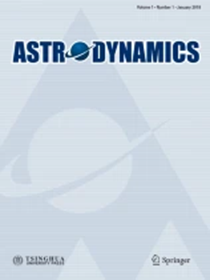Terminal guidance and control algorithms for kinetic impact missions on 30-m-diameter asteroids
Abstract
Kinetic impact is an effective approach for studying and defending against asteroids. Impact missions have focused on asteroids with diameters larger than 100 m, whereas smaller missions have not been explored. Terminal guidance and control algorithms for small asteroids have received limited attention. China plans to conduct its first asteroid defense demonstration mission around 2025 on a 30-m-diameter asteroid. This paper presents the guidance and control algorithms for the terminal phase of this mission. The guidance formulas for impact missions are derived in this study using predictive and proportional guidance laws. Three maneuver criteria are proposed to determine the optimal timing for orbit correction, considering fuel consumption, impact accuracy, and computational cost. A continuous thrust control strategy was introduced to achieve incremental changes in velocity based on the relative motion of the impactor and target. The performance of the guidance and control algorithms was evaluated using Monte Carlo simulation, which demonstrated their effectiveness in handling uncertainties and achieving a high success rate. The results indicate that the proposed algorithm can be applied to future impact missions targeting small asteroids.

 求助内容:
求助内容: 应助结果提醒方式:
应助结果提醒方式:


